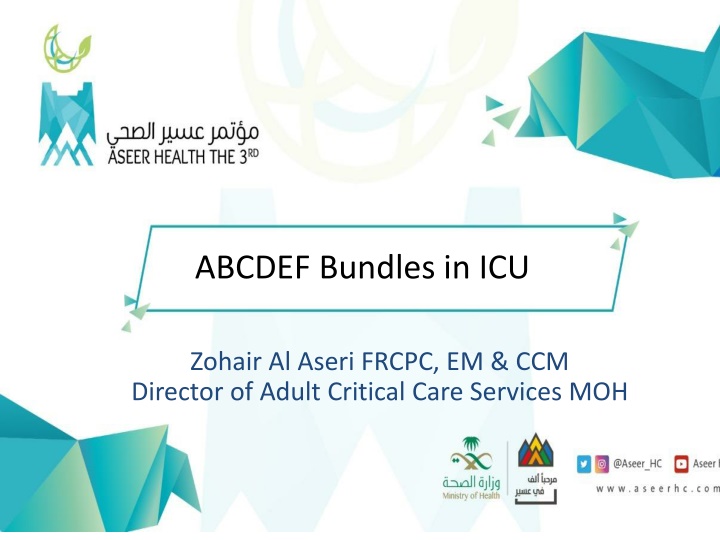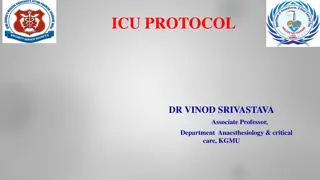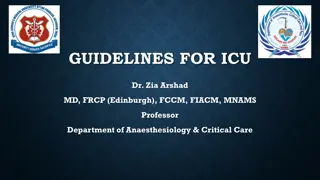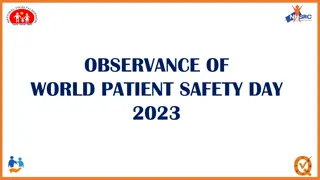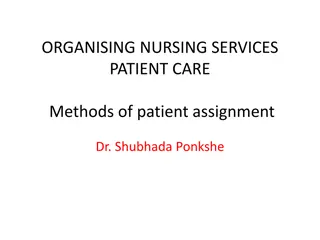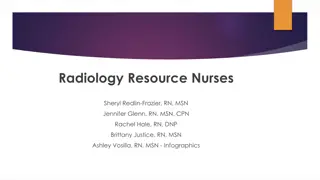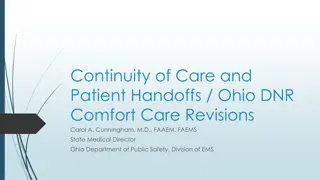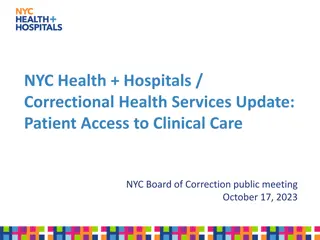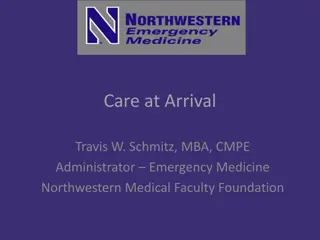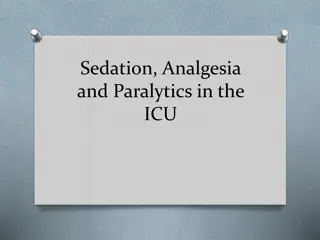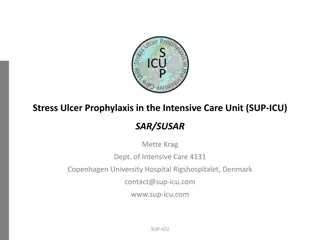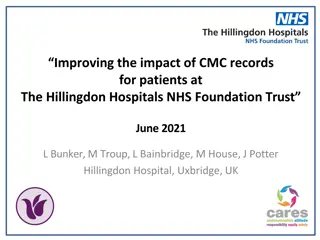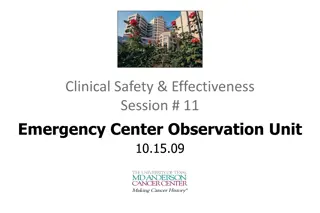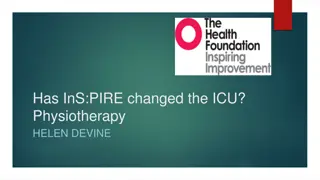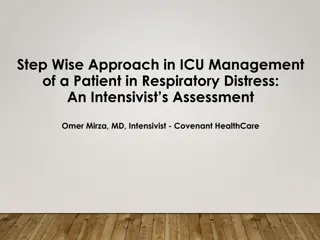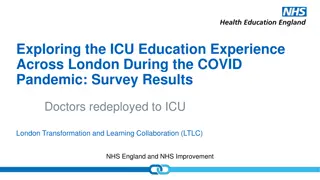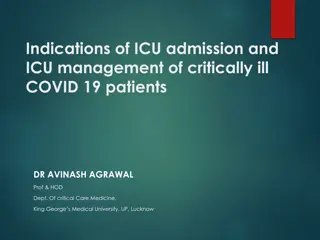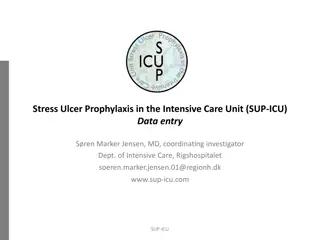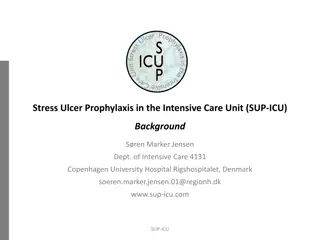ABCDEF Bundles in ICU: Improving Patient Care and Safety
The benefits of ABCDEF Bundles in ICU for improving patient outcomes, reducing long-term consequences, and enhancing safety. Learn about pain management, delirium prevention, early mobility, family engagement, and optimal resource utilization. Discover strategies for incorporating bundle data into electronic health records and creating a culture of safety in the ICU. Find out how the NASAM ABCDEF bundle can help in assessing, preventing, and managing pain, as well as enhancing patient care in the ICU
Download Presentation

Please find below an Image/Link to download the presentation.
The content on the website is provided AS IS for your information and personal use only. It may not be sold, licensed, or shared on other websites without obtaining consent from the author.If you encounter any issues during the download, it is possible that the publisher has removed the file from their server.
You are allowed to download the files provided on this website for personal or commercial use, subject to the condition that they are used lawfully. All files are the property of their respective owners.
The content on the website is provided AS IS for your information and personal use only. It may not be sold, licensed, or shared on other websites without obtaining consent from the author.
E N D
Presentation Transcript
ABCDEF Bundles in ICU Zohair Al Aseri FRCPC, EM & CCM Director of Adult Critical Care Services MOH
NASAM ABCDEF bundle: ABCDEF Assess, Prevent, and Manage Pain Both Spontaneous Awakening Trials (SAT) and Spontaneous Breathing Trials (SBT) Choice of analgesia and sedation Delirium: Assess, Prevent, and Manage. Early mobility and Exercise Family engagement and empowerment
ABCDEF Bundle Instead of waiting for patients to get better helps ICU patients get better FASTER.
Incorporation of bundle data into electronic health Culture of safety in the ICU Requirements Strong ICU and hospital leadership support and engagement Collaborative work environment; NASAM
Factors related to Hospitalization-Associated disability Data from Covinsky KE, Pierluissi E, Johnston CB. Hospitalization-associated disability: "She was probably able to ambulate, but I'm not sure". JAMA. 2011 Oct 26;306(16):1782 93. doi: 10.1001/jama.2011.1556.
Improving Value, Quality, and Safety in Your ICU with the ICU Liberation Campaign The most common preventable ICU harms: Delirium Acquired weakness Device-related infections DVT Pressure ulcers 1/5 ICU patients are harmed by adverse events events are preventable.
Reduce long-term consequences. Well- rounded patient care Better controlled pain ABCDEF bundle Optimal resource utilization Reduce delirium, more interactive ICU patients NASAM
A: Assess, Prevent, and Manage Pain Pain in ICU patients Up to 50% Common ICU procedures induce a significant pain Three most painful procedures: 1.Chest tube removal 2.Wound drain removal 3.Arterial line insertion
A: Assess, Prevent, and Manage Pain Assessment of pain 1st step before administering pain relief. Pain and delirium interrelatedness. Treating pain is important in the prevention and/or management of delirium Only in 35% of the time before ICU procedures!! need improvement
A: Assess, Prevent, and Manage Pain Assessment of pain Scale Numerical rating scale (NRS) Gold standard: Patient's self-report 1 10
A: Assess, Prevent, and Manage Pain For non-self reporting patient, use observable behavioral and physiological indicators 1.Behavioral Pain Scale (BPS) 1.Critical-Care Pain Observation Tool (CPOT) Valid & Reliable. Provide selection of pain meds. Evaluate pain meds effectiveness.
A: Assess, Prevent, and Manage Pain BPS Composed of 3 subscales: 1.Facial expression 2.Movement of the upper limbs 3.Compliance with mechanical Ventilation 1 (no response) to 4 (full response). 5 or higher is considered to reflect unacceptable pain.
A: Assess, Prevent, and Manage Pain CPOT 4 components: 1.facial expression 2.body movements 3.muscle tension 4.compliance with the ventilator for intubated patients or vocalization for extubated patients. 0 to 2 with a possible total score ranging from 0 to 8 A CPOT 3 is indicative of significant pain.
A: Assess, Prevent, and Manage Pain Pain medications for: Significant pain NRS >4 BPS >5 CPOT >3 Prior to painful invasive procedures
A: Assess, Prevent, and Manage Pain Parenteral opioids First-line for treating non-neuropathic pain.
A: Assess, Prevent, and Manage Pain For neuropathic pain Gabapentin Carbamazepine Opioids Adjunctive medications to reduce opioid and its side effects: Non-opioid analgesics: Acetaminophen NSAID Ketamine
A: Assess, Prevent, and Manage Pain Use of regional analgesia Ie, epidural analgesia surgical patients traumatic rib fractures. Non-pharmacological methods Effective and safe injury stabilization patient repositioning use of heat/cold
Pain, agitation, and delirium (PAD) PAD New admission, new environment, agitation. multiple sedatives, opioids, and antipsychotics deep sedation and prolonged mechanical ventilation
Both Spontaneous Awakening Trials (SAT) and Spontaneous Breathing Trials (SBT) Pts. receiving SATs with SBTs were less likely to die than pts receiving only SBTs (p=0 01). For every 7 pts treated with the intervention, one life was saved (number needed to treat was 7.4,).
Spontaneous Awakening Trials (SAT) Spontaneous Breathing Trials (SBT) Core of NASAM Light sedation earlier extubation Deep Sedation DailY SATs Stopping narcotics (as pain is controlled) & sedatives every day Risk factor for ICU Morbidity If needed, restarting either at previous dose & titrating LOWER mechanical ventilation and ICU length
C: Choice of analgesia and sedation Goal-directed delivery of psychoactive medications: By using sedation scales PAD guidelines recommend: Richmond Agitation-Sedation Scale (RASS) Riker Sedation-Agitation Scale (SAS).
RAS OR SAS Core of NASAM non-benzodiazepine sedative benzodiazepine -based sedative earlier extubation SAS RASS Deep Sedation Light sedation Sedation scale Sedation protocols Risk factor for ICU Morbidity LOWER mechanical ventilation and ICU length
D: Delirium: Assess, Prevent, and Manage Delirium Disturbance in attention and awareness Develops over a short period of time, hours to days Fluctuates over time. Over 80% of pts developed delirium during hospital stay Onset between 2nd and the 3rd day.
D: Delirium: Assess, Prevent, and Manage Tow most frequently used tools to diagnose delirium in ICU: 1. Confusion Assessment Method for the Intensive Care Unit (CAM-ICU) 1. Intensive Care Delirium Screening Checklist (ICDSC)
E: Early mobility The only intervention resulting in a decrease in days of delirium. ICU-acquired weakness ranges from 25 to 100%. ICU patients can lose up to 25% peripheral muscle weakness within Four days when mechanically ventilated
D: Delirium: Assess, Prevent, and Manage Early mobilization & SAT + Reduce incidence and duration of ICU delirium Improve functional outcomes Decrease mortality More days off vent = Promoting sleep hygiene to prevent sleep disruption
E: Early mobility Will not improve long-term functioning when started after 4thday Early in the ICU better than late Rehabilitation should begin in the ICU and continue to recovery at home. Close collaboration and coordination with all needed services.
F: Family engagement Intervention Benefits Patients preferences can be identified * Family decision makers is active in decision-making * Ethics & palliative consultation * Routine family conference Anxiety of families can be lessened Reduce ICU length for terminal cases Physicians can have appropriate input
A,B,C,D,E&F to all ICU patients at the right time: It is an interdependent, complex, and dynamic process. Requires coordination and collaboration of providers across disciplines.
Bundling evidence-based practices Reduce variation & Improve ICU team communication Standardize care processes Increasing patient mobility Reducing prevalence of delirium Reducing duration of mechanical ventilation Reduce ICU mortality
NASAM High- performing ICUs High-intensity ICU physician staffing Daily ICU Goals sheets Checklists Protocols Adequate ICU nurse staffing Daily Multiprofessional rounds
ABCDEF & EHR Incorporate bundle elements into HER Bundle elements are addressed for every ICU patient, every day Work flows are standardized. Extraction of bundle compliance, performance, and outcome reports from the EHR Translate evidence into clinical practice Reduce ICU clinician practice variation
Caring for Critically Ill Patients with the ABCDEF Bundle: Results of the ICU Liberation Collaborative in Over 15,000 Adults. Prospective, multicenter, cohort 68 ICUs over 20-month period 15,226 adults To look at the association between complete and proportional ABCDEF bundle and 3 sets of outcomes: 1. Patient-related (mortality, ICU and hospital discharge) 2. Symptom-related (mechanical ventilation, coma, delirium, pain, restraint use) 3. System-related (ICU readmission, discharge destination) Pun, Brenda T. Critical Care Medicine: January 2019 - Volume 47 - Issue 1
Caring for Critically Ill Patients with the ABCDEF Bundle: Results of the ICU Liberation Collaborative in Over 15,000 Adults. Results: Complete ABCDEF bundle performance was associated with lower likelihood of seven outcomes: Hospital death within 7 days Next-day mechanical ventilation Coma Delirium Physical restraint use ICU readmission Discharge to a facility other than home A consistent relationship between higher bundle performance & improvements in each clinical outcomes (all p < 0.002). Pun, Brenda T. Critical Care Medicine: January 2019 - Volume 47 - Issue 1
Caring for Critically Ill Patients with the ABCDEF Bundle: Results of the ICU Liberation Collaborative in Over 15,000 Adults Pun, Brenda T. Critical Care Medicine: January 2019 - Volume 47 - Issue 1 - p 3-14 doi: 10.1097/CCM.0000000000003482 Society of Critical Care Medicine. Critical care statistics. Mt. Prospect, IL: Society of Critical Care Medicine. https://www.sccm.org/Communications/Critical-Care-Statistics. Accessed July 9, 2018. Rothschild JM, Landrigan CP, Cronin JW, et al. The Critical Care Safety Study: The incidence and nature of adverse events and serious medical errors in intensive care. Crit Care Med. 2005 Aug;33(8):1694-1700. Kaushal R, Bates DW, Franz C, Soukup JR, Rothschild JM. Cost of adverse events in intensive care units. Crit Care Med. 2007 Nov;35(11):2479-2483. Barr J, Fraser GL, Puntillo K, et al; American College of Critical Care Medicine. Clinical practice guidelines for the management of pain, agitation, and delirium in adult patients in the intensive care unit. Crit Care Med. 2013 Jan;41(1):263-306. Needham DM, Davidson J, Cohen H, et al. Improving long-term outcomes after discharge from intensive care unit: report from a stakeholders conference. Crit Care Med. 2012 Feb; 40(2):502-509. Marra A, Pandaripande PP, Girard TD, et al. Cooccurrence of post-intensive care syndrome problems among 406 survivors of critical illness. Crit Care Med. 2018 May 21. [Epub ahead of print]. Elliott D, Davidson JE, Harvey MA, et al. Crit Care Med. 2014 Dec; 42(12):2518-2526. Harvey MA, Davidson JE. Postintensive care syndrome: right care, right now . . . and later. Crit Care Med. 2016 Feb;44(2):381-385. Davidson JE, Harvey MA. Patient and family post-intensive care syndrome. AACN Adv Crit Care. 2016 April-June;27(2):184-186. ICU Liberation. ABCDEF bundle. http://www.iculiberation.org/Bundles/Pages/default.aspx. Mt. Prospect, IL: Society of Critical Care Medicine. Accessed June 12, 2018. Balas MC, Vasilevskis EE, Olsen KM, et al. Effectiveness and safety of the awakening and breathing coordination, delirium monitoring/management, and early exercise/mobility bundle. Crit Care Med. 2014 May;42(5):1024-1036. Barnes-Daly MA, Phillips G, Ely EW. Improving hospital survival and reducing brain dysfunction at seven California community hospitals: implementing PAD guidelines via the ABCDEF bundle in 6,064 patients. Crit Care Med. 2017 Feb;45(2):171-178. Donovan AL, Aldrich JM, Gross AK, et al; University of California San Francisco Critical Care Innovations Group. Interprofessional care and teamwork in the ICU. Crit Care Med 2018 Jun;46(6):980-990. Balas MC, Burke WJ, Gannon D, et al. Implementing the awakening and breathing coordination, delirium monitoring/management, and early exercise/mobility bundle into everyday care: opportunities, challenges, and lessons learned for implementing the ICU pain, agitation, and delirium guidelines. Crit Care Med 2013 Sep;41(9 Suppl 1):S116-S127. Costa DK, Barg FK, Asch DA, Kahn JM. Facilitators of an interprofessional approach to care in medical and mixed medical/surgical ICUs a multicenter qualitative study. Res Nurs Health. 2014 Aug;37(4):326-335. Harvard Business Review. Want to be a more supportive leader? Here s how. June 25, 2018. Boston, MA: Harvard Business School Publishing Corporation. https://www.physicianleaders.org/news/want-more-supportive-leader-heres-how. Accessed June 27, 2018. Kambil A. Four types of executive sponsorship to catalyze change. October 11, 2017. New York, NY: Deloitte Insights. https://www2.deloitte.com/insights/us/en/focus/executive-transitions/four-types-of-executive-sponsorship-to-catalyze-change.html. Accessed June 27, 2018. Institute for Healthcare Improvement. The IHI Triple Aim. Boston, MA: Institute for Healthcare Improvement; 2018. http://www.ihi.org/Engage/Initiatives/TripleAim/Pages/default.aspx. Accessed July 24, 2018 references
Delirium Assessment Pain scale & TTT Sleep hygiene Bundles for Critical Care Pateints NASAM No Benzo SBT Family particip ation SAT Early mobilization
Thank you NASAM Q&A
